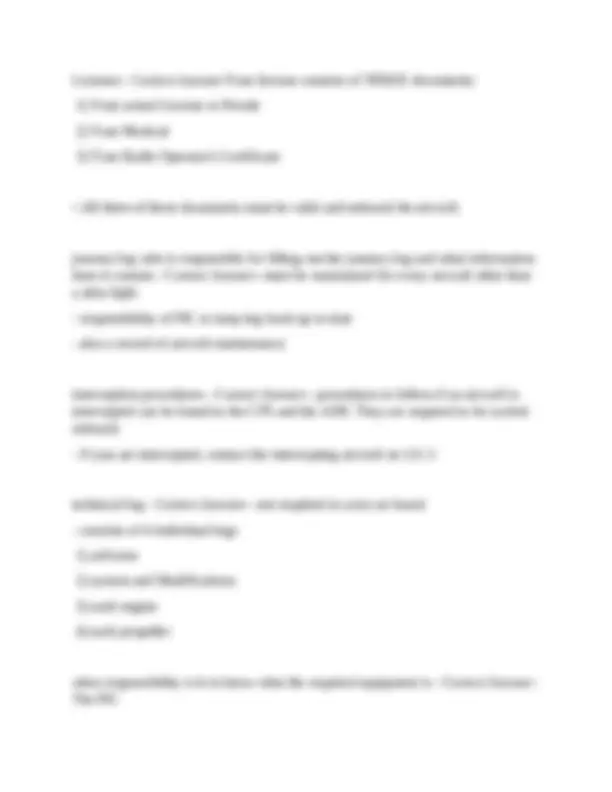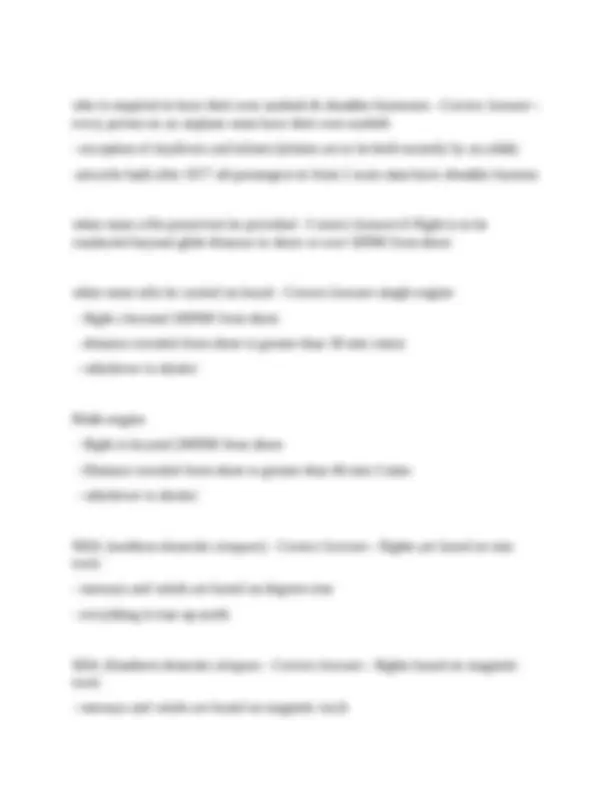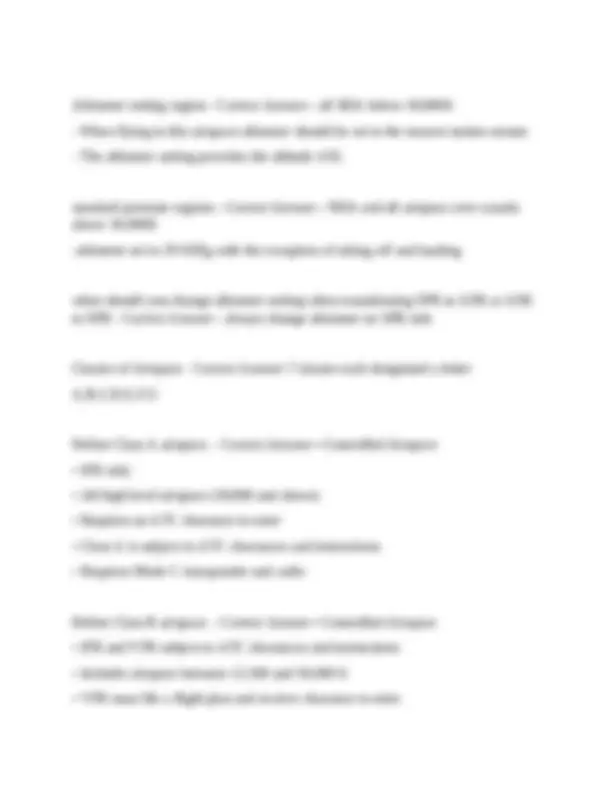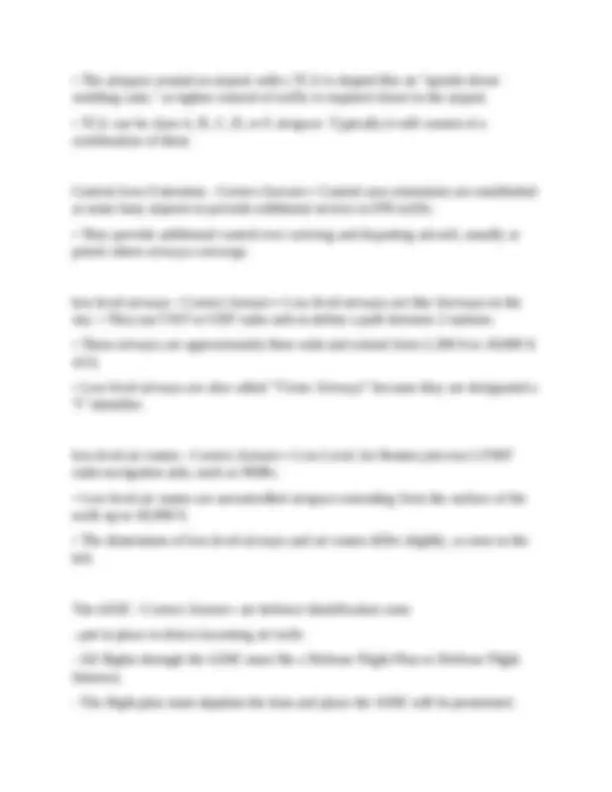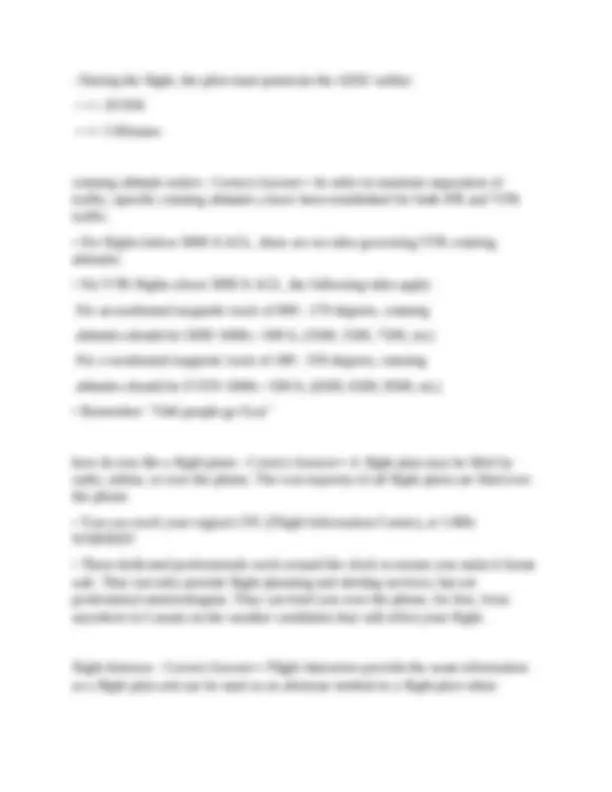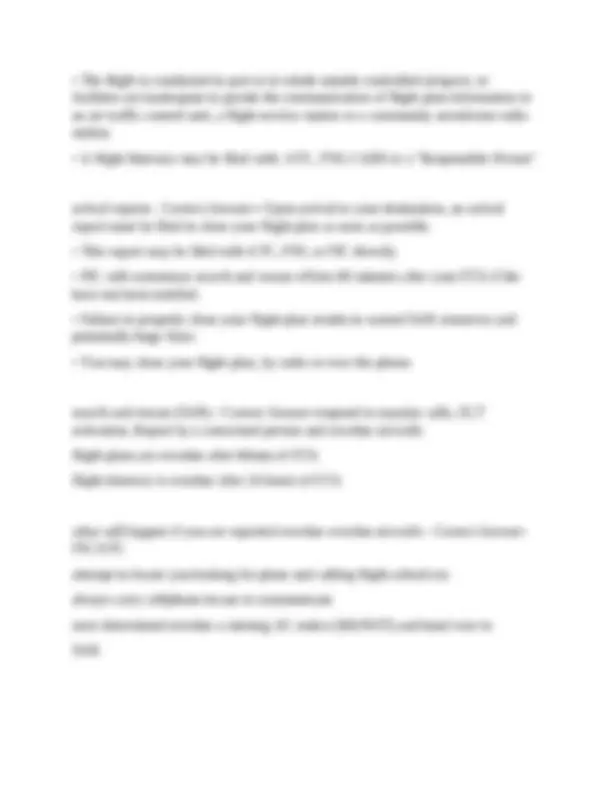Download Unit 9 - Canadian Aviation Regulations (Part 2). Questions with Correct Answers and more Exams Nursing in PDF only on Docsity!
Unit 9 - Canadian Aviation Regulations (Part 2).
Questions with Correct Answers
required documentation - Correct Answer-documents required onboard AROWILLI Certificate of Airworthiness Certificate of Registration Pilots Operating Handbook Aircraft Weight and Balance Insurance Certificate Licenses Journey Log Interception Procedures Certificate of Airworthiness - Correct Answer-- Every certified aircraft is issued a Certificate of Airworthiness if it is deemed by the Minister (Transport Canada), to be safe to fly.
- The certificate of airworthiness, or "C of A," is typically issued after the aircraft is imported to Canada. certificate of registration - Correct Answer--The primary purpose of this document is to determine who is responsible for the aircraft. -valid indefinitely -contains the following info The aircraft's registration mark The aircraft's make and model
The aircraft's purpose The aircraft's serial number The registered owner The issue date The signature of the Minister transfer of ownership - Correct Answer-• If aircraft is sold, the vendor completes transfer of ownership card.
- The new owner fills out the back of the old C of R with the new owner's information, address, etc.
- The new owner also fills out the Interim Certificate of Registration which acts as a temporary C of R.
- The new owner must notify Transport Canada within 7 days of change
- An aircraft's purpose may be Private, Commercial, or State
- The registered owner is the person, company, or organization which is responsible for the airplane. They are not necessarily the actual owner. POH (pilot operating handbook) - Correct Answer-- describes correct operating procedures -must be carried on aircraft at all times when does a aircraft greater than 12,500 lbs get reweighed - Correct Answer-every 5 years insurance - Correct Answer--must be carried on board
who is required to have their own seatbelt & shoulder harnesses - Correct Answer-- every person on an airplane must have their own seatbelt
- exception of skydivers and infants (infants are to be held securely by an adult) -aircrafts built after 1977 all passengers in front 2 seats must have shoulder harness when must a life preservers be provided - Correct Answer-if flight is to be conducted beyond glide distance to shore or over 50NM from shore when must rafts be carried on board - Correct Answer-single engine
- flight s beyond 100NM from shore
- distance traveled from shore is greater than 30 min cruise
- whichever is shorter Multi-engine
- flight is beyond 200NM from shore
- Distance traveled from shore is greater than 60 min Cruise
- whichever is shorter NDA (northern domestic airspace) - Correct Answer-- flights are based on true track
- runways and winds are based on degrees true
- everything is true up north SDA (Southern demestic airspace - Correct Answer-- flights based on magnetic track
- runways and winds are based on magnetic track
Altimeter setting region - Correct Answer-- all SDA below 18,000ft
- When flying in this airspace altimeter should be set to the nearest station enoute.
- The altimeter setting provides the altitude ASL. standard pressure regions - Correct Answer-- NDA and all airspace over canada above 18,000ft -altimeter set to 29.92Hg with the exception of taking off and landing when should you change altimeter setting when transitioning SPR to ASR or ASR to SPR - Correct Answer-- always change altimeter on SPR side Classes of Airspace - Correct Answer-7 classes each designated a letter A,B,C,D,E,F,G Define Class A airspace. - Correct Answer-• Controlled Airspace
- IFR only
- All high level airspace (18,000 and above)
- Requires an ATC clearance to enter
- Class A is subject to ATC clearances and instructions
- Requires Mode C transponder and radio Define Class B airspace. - Correct Answer-• Controlled Airspace
- IFR and VFR subject to ATC clearances and instructions
- Includes airspace between 12,500 and 18,000 ft
- VFR must file a flight plan and receive clearance to enter
CYA - Advisory Airspace - Traffic is encouraged to avoid the area for flight safety purposes CYR - Restricted Airspace - No one may enter unless prior permission is obtained CYD - Dangerous Airspace - Absolutely no entry due to hazardous conditions Define Class G airspace - Correct Answer-• Class G is uncontrolled airspace
- ATC has no authority or responsibility for exercising control over air traffic
- Flying in uncontrolled airspace means having to worry less about following specific regulations, however ATC provides absolutely zero service. In uncontrolled airspace, you are all on your own. Extra care must be taken to ensure a safe flight. what is a Control Zones - Correct Answer-• Control Zones are in place around certain airports in order to keep IFR traffic within controlled airspace and facilitate control over IFR and VFR traffic.
- Control zones ensure that busier airspace and the traffic taxiing on the ground is all coordinated and safe.
- ATC provides a number of services within control zones.
- Control Zones are depicted on aeronautical charts as a ring around an airport. The type of ring depicts the class of airspace composing the control zone.
- Information on the control zone, its airspace, and its services can also be found in the CFS Terminal Control Area - Correct Answer-• Terminal Control Areas are established at larger airports with higher volumes of traffic.
- In place to provide service to arriving, departing, and enroute IFR traffic.
- The airspace around an airport with a TCA is shaped like an "upside-down wedding cake," as tighter control of traffic is required closer to the airport.
- TCA can be class A, B, C, D, or E airspace. Typically it will consist of a combination of these. Control Area Extension - Correct Answer-• Control area extensions are established at some busy airports to provide additional service to IFR traffic.
- They provide additional control over arriving and departing aircraft, usually at points where airways converge. low level airways - Correct Answer-• Low level airways are like freeways in the sky. • They use VHF or UHF radio aids to define a path between 2 stations.
- These airways are approximately 8nm wide and extend from 2,200 ft to 18,000 ft AGL
- Low level airways are also called "Victor Airways" because they are designated a 'V' identifier. low level air routes - Correct Answer-• Low Level Air Routes join two LF/MF radio navigation aids, such as NDBs.
- Low level air routes are uncontrolled airspace extending from the surface of the earth up to 18,000 ft.
- The dimensions of low level airways and air routes differ slightly, as seen to the left. The ADIZ - Correct Answer--air defence identification zone
- put in place to detect incoming air trafic
- All flights through the ADIZ must file a Defense Flight Plan or Defense Flight Itinerary.
- The flight plan must stipulate the time and place the ADIZ will be penetrated.
- The flight is conducted in part or in whole outside controlled airspace; or facilities are inadequate to permit the communication of flight plan information to an air traffic control unit, a flight service station or a community aerodrome radio station.
- A flight Itinerary may be filed with: ATC, FSS, CARS or a "Responsible Person" arrival reports - Correct Answer-• Upon arrival to your destination, an arrival report must be filed to close your flight plan as soon as possible.
- This report may be filed with ATC, FSS, or FIC directly.
- FIC will commence search and rescue efforts 60 minutes after your ETA if the have not been notified.
- Failure to properly close your flight plan results in wasted SAR resources and potentially huge fines.
- You may close your flight plan, by radio or over the phone. search and rescue (SAR) - Correct Answer-respond to mayday calls, ELT activation, Report by a concerned person and overdue aircrafts flight plans are overdue after 60min of ETA flight itinerary is overdue after 24 hours of ETA what will happen if you are reported overdue overdue aircrafts - Correct Answer- FIC/ATC attempt to locate you looking for plane and calling flight school ect. always carry cellphone incase to communicate once determined overdue a missing AC notice (MANOT) and hand over to SAR
SAR response, where will they look and what will they look for? - Correct Answer-they will begin the search over your filed flight plan from the last known position report -they will look/listen for radio communication, ELT signal, Visual signal (flares, mirrors, signal fire...), signs of wreckage/crash site accidents - Correct Answer-an occurrence where a person was hurt or killed; where an aircraft is seriously damaged; or where an aircraft goes missing. incidents - Correct Answer-- involves any aircraft over 12,500 lbs, where a serious situation develops. For example, a control malfunction, depressurization, near collision, anything causing a deviation from normal procedures. who's responsibility is it to ensure there is no ice or frost on the aircraft - Correct Answer-the PIC when does a aircraft less than 12,500 lbs get reweighed - Correct Answer-at the AME's discretion what changes to the plane would result in re-weighing - Correct Answer-2% of total weight weight changes difficult to count (painting) once a journey log is full how long must it be kept - Correct Answer--1 year with the last 2 entries carried over to the new journey log
when must the journey log be carried on board - Correct Answer-flights exceeding 25NM

